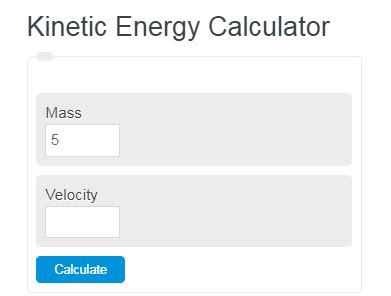Enter the mass of an object and its velocity to calculate its current kinetic energy. This can also be calculated through momentum and mass.
- All Energy Calculators
- Velocity Calculator
- Momentum Calculator
- Potential Energy Calculator
- Energy Density Calculator
- Total Kinetic Energy Calculator
Kinetic Energy Formula
The following formula can be used to calculate the instantaneous kinetic energy of an object in motion.
(K) = 1/2 *(m)*(v)^2
- Where K is kinetic energy in Joules (J)
- m is mass (kg)
- and v is velocity (m/s)
It can also be calculated through its relationship to momentum, which is really more about the relationship between velocity and momentum.
(K) = (p) ^2 / 2 * (m)
- Where K is kinetic energy
- p is momentum
- and m is mass
Kinetic Energy is the energy an object possesses due to its motion. It’s further defined as the work needed to accelerate an object to a certain velocity. The standard SI unit for kinetic energy is joules (J).
Kinetic Energy is just one of many forms of energy. There’s chemical energy, electromagnetic energy, gravitational energy, nuclear energy, and more. Kinetic energy is the one that deals specifically with motion and the energy that comes from that motion. Another general form of energy is potential energy.
How to Calculate Kinetic Energy
We will now go over a detailed example of how to calculate kinetic energy. This problem will involve an object that is moving at a constant speed over a certain distance. The values given are mass, change in position, and time elapsed.
Mass = 100 kg
Change in position = 20m
Time elapsed = 4s
- First, we need to calculate the velocity of this object. For a more detailed explanation on how to find the velocity of an object, click here. For our purposes, we know that velocity is equal to the change in position divided by time. So 20m/4s = 5m/s.
- The next step is to enter our information into the formula described above. K = 1/2 *(m)*(v)^2 = 1/2* 100kg*(5m/s)^2 = 1,250.00 Joules
- The last step is to analyze the results and check the math using the calculator above.
Kinetic Energy Examples
- When jumping up and down a person’s body has kinetic energy
- When driving in a car, both the car and everything else in it has kinetic energy
- When a soccer ball is kicked it is forced into motion and has kinetic energy
- When throwing a football, the football is in motion and has kinetic energy
In short, any object that has a mass and movement contains some amount of kinetic energy.

